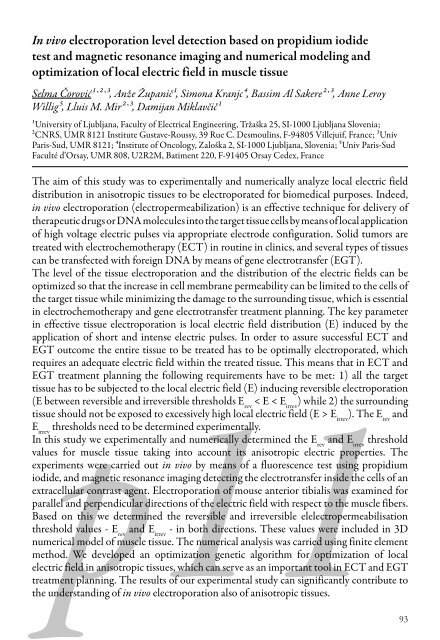Create successful ePaper yourself
Turn your PDF publications into a flip-book with our unique Google optimized e-Paper software.
In vivo electroporation level detection based on propidium iodide<br />
test and magnetic resonance imaging and numerical modeling and<br />
optimization <strong>of</strong> local electric field in muscle tissue<br />
Selma Čorović1 ,2 ,3, Anže Županič1, Simona Kranjc4, Bassim Al Sakere2 ,3, Anne Leroy<br />
Willig5, Lluis M. Mir2 ,3, Damijan Miklavčič1<br />
1University <strong>of</strong> Ljubljana, Faculty <strong>of</strong> Electrical Engineering, Tržaška 25, SI-1000 Ljubljana Slovenia;<br />
2CNRS, UMR 8121 Institute Gustave-Roussy, 39 Rue C. Desmoulins, F-94805 Villejuif, France; 3Univ<br />
Paris-Sud, UMR 8121; 4Institute <strong>of</strong> Oncology, Zaloška 2, SI-1000 Ljubljana, Slovenia; 5Univ Paris-Sud<br />
Faculté d’Orsay, UMR 808, U2R2M, Batiment 220, F-91405 Orsay Cedex, France<br />
The aim <strong>of</strong> this study was to experimentally and numerically analyze local electric field<br />
distribution in anisotropic tissues to be electroporated for biomedical purposes. Indeed,<br />
in vivo electroporation (electropermeabilization) is an effective technique for delivery <strong>of</strong><br />
therapeutic drugs or DNA molecules into the target tissue cells by means <strong>of</strong> local application<br />
<strong>of</strong> high voltage electric pulses via appropriate electrode configuration. Solid tumors are<br />
treated with electrochemotherapy (ECT) in routine in clinics, and several types <strong>of</strong> tissues<br />
can be transfected with foreign DNA by means <strong>of</strong> gene electrotransfer (EGT).<br />
The level <strong>of</strong> the tissue electroporation and the distribution <strong>of</strong> the electric fields can be<br />
optimized so that the increase in cell membrane permeability can be limited to the cells <strong>of</strong><br />
the target tissue while minimizing the damage to the surrounding tissue, which is essential<br />
in electrochemotherapy and gene electrotransfer treatment planning. The key parameter<br />
in effective tissue electroporation is local electric field distribution (E) induced by the<br />
application <strong>of</strong> short and intense electric pulses. In order to assure successful ECT and<br />
EGT outcome the entire tissue to be treated has to be optimally electroporated, which<br />
requires an adequate electric field within the treated tissue. This means that in ECT and<br />
EGT treatment planning the following requirements have to be met: 1) all the target<br />
tissue has to be subjected to the local electric field (E) inducing reversible electroporation<br />
(E between reversible and irreversible thresholds E rev<br />
< E < E irrev<br />
) while 2) the surrounding<br />
tissue should not be exposed to excessively high local electric field (E > E irrev<br />
). The E rev<br />
and<br />
E irrev<br />
thresholds need to be determined experimentally.<br />
In this study we experimentally and numerically determined the E rev<br />
and E irrev<br />
threshold<br />
values for muscle tissue taking into account its anisotropic electric properties. The<br />
experiments were carried out in vivo by means <strong>of</strong> a fluorescence test using propidium<br />
iodide, and magnetic resonance imaging detecting the electrotransfer inside the cells <strong>of</strong> an<br />
extracellular contrast agent. Electroporation <strong>of</strong> mouse anterior tibialis was examined for<br />
parallel and perpendicular directions <strong>of</strong> the electric field with respect to the muscle fibers.<br />
Based on this we determined the reversible and irreversible elelectropermeabilisation<br />
threshold values - E rev<br />
and E irrev<br />
- in both directions. These values were included in 3D<br />
numerical model <strong>of</strong> muscle tissue. The numerical analysis was carried using finite element<br />
method. We developed an optimization genetic algorithm for optimization <strong>of</strong> local<br />
electric field in anisotropic tissues, which can serve as an important tool in ECT and EGT<br />
p1193<br />
treatment planning. The results <strong>of</strong> our experimental study can significantly contribute to<br />
the understanding <strong>of</strong> in vivo electroporation also <strong>of</strong> anisotropic tissues.
















